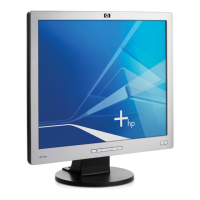
Do you have a question about the HP L1906 and is the answer not in the manual?
| 3D | No |
|---|---|
| Pixel pitch | 0.294 x 0.294 mm |
| Display diagonal | 19 \ |
| Display resolution | 1280 x 1024 pixels |
| Vertical scan range | 50 - 76 Hz |
| Horizontal scan range | 30 - 83 kHz |
| Viewing angle, vertical | 130 ° |
| Contrast ratio (dynamic) | - |
| Contrast ratio (typical) | 500:1 |
| Display number of colors | 16.78 million colors |
| Viewing angle, horizontal | 140 ° |
| Display brightness (typical) | 270 cd/m² |
| Supported graphics resolutions | 1280 x 1024 (SXGA) |
| On/off switch | Yes |
| DVI-D ports quantity | 0 |
| Tilt angle range | 0 - 15 ° |
| Panel mounting interface | 100 x 100 mm |
| AC input voltage | 100 - 240 V |
| AC input frequency | 50 - 60 Hz |
| Power consumption (max) | 37 W |
| Power consumption (standby) | 2 W |
| Power consumption (typical) | 33 W |
| Certification | CISPR, VCCI, CSA, TUV, GS, CCC, MIC, FCC, UL, GOST, SASO |
| Product color | Black, Silver |
| Country of origin | China |
| Market positioning | Business |
| Operating temperature (T-T) | 10 - 35 °C |
| Storage relative humidity (H-H) | 5 - 90 % |
| Operating relative humidity (H-H) | 20 - 80 % |
| Package weight | 7000 g |
| Sustainability certificates | ENERGY STAR |
| Depth (with stand) | 203 mm |
|---|---|
| Height (with stand) | 427 mm |
| Weight (with stand) | 5300 g |
| Depth (without stand) | 59 mm |
| Width (without stand) | 422 mm |
| Height (without stand) | 362 mm |
| Weight (without stand) | - g |
General safety warning for service personnel.
Caution about using an isolation transformer during servicing.
Specifications related to the LCD panel.
Details on input signals and timing.
Power consumption and operating conditions.
Physical size and weight of the monitor.
Visual representation of the monitor's internal components.
Basic steps for turning on and connecting the monitor.
Explanation of each button's purpose and operation.
Detailed pin configuration for the VGA connector.
Supported resolutions, frequencies, and timing.
Key characteristics of the LCD panel.
Physical dimensions and operating environment limits.
Visual breakdown of monitor components for assembly/disassembly.
Schematic representation of the scalar board.
Schematic of the inverter circuit.
Detailed circuit diagram of the main board.
Physical layout of components on the main board.
List of necessary tools for service.
Troubleshooting steps for the main board.
Steps for diagnosing and fixing display issues.
Steps for diagnosing and fixing panel power issues.
Steps to diagnose and fix power board issues.
Steps for diagnosing and fixing backlight issues.
Troubleshooting steps for the keyboard.
